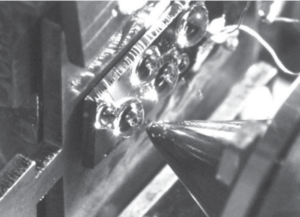
Héloïse Tissot
Research Topics
Study of model systems for understanding chemical reactions at the solid/gas interface
Although the principle of heterogeneous catalysis is known, it remains challenging to precisely describe the mechanisms that occur during a catalytic reaction on a substrate. Indeed, the complexity and often the heterogeneity of the catalysts used in industry make their characterization and understanding difficult. It is therefore interesting to synthesize model catalysts whose activity will certainly be lower but for which understanding the structure, physical or chemical properties, and reactivity will be easier thanks to the use of various spectroscopic techniques.
Operando study of a model catalyst based on Cu2O nanoparticles on alumina.
The aim of this project is to study the evolution of the properties of Cu2O nanoparticles as a function of their size and shape in the presence of a gas atmosphere and during a catalytic reaction. How will the nanoparticles be modified? Do they retain their initial structure? Can we identify the active site of the catalytic reaction? To achieve this, we first need to synthesize Cu2O nanoparticles with controlled size and shape. These nanoparticles are then deposited on single-crystal alumina surfaces with different orientations to study the interaction between the nanoparticles and the various surfaces while controlling the morphology of both the surface and the nanoparticles to the fullest extent possible. Finally, the reactivity of these surfaces is studied operando using Near Ambient Pressure X-ray Photoelectron Spectroscopy (NAP-XPS) to track the structural and chemical modifications induced by a gas phase (under oxygen, hydrogen atmospheres, etc.) and during a chemical reaction (model reaction: CO oxidation).

Properties and Reactions at the Interfaces of Aqueous Solutions.
Near Ambient Pressure X-ray Photoelectron Spectroscopy (NAP-XPS) allows us to move beyond studies under ultra-high vacuum conditions and increase the pressure in the analysis chamber to approximately 10 mbar. Under these conditions, it is possible to study solid/liquid or liquid/gas interfaces. In particular, we have focused on studying the surface of water droplets to better understand the distribution of ions near the surface, as well as the challenges related to the use of NAP-XPS (energy referencing, radiolysis, etc.).
Radiolytic oxidation in aqueous halide solutions.
NAP-XPS is a valuable tool for studying gas/liquid and liquid/solid interfaces. However, concerns have emerged regarding X-ray beam damage, especially in experiments involving condensed liquid water. This study examines the radiolytic effects on the chemistry of concentrated sodium halide solutions (NaX, X = Cl, Br, I) and on a layered double hydroxide [Mg2Al(OH)6]+[Cl−]. The study analyzes the impact of known parameters (irradiation dose) on the abundance of XO− ions. The observed variations in the data appear to result from still poorly understood or insufficiently controlled parameters (such as solute concentration or solution hydrodynamics). Understanding and controlling these radiolytic effects improves the reliability of synchrotron NAP-XPS analysis for relevant interfaces in environmental chemistry and electrochemistry.



